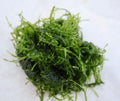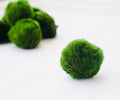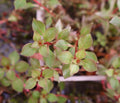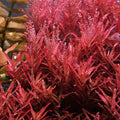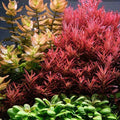Buce Plant Care Guide
Most people consider anubias or java ferns when they think of aquarium plants that are easy for beginners. Try Bucephalandra instead if you're searching for something a little more distinctive.
This wonderful plant is ideal for nano aquariums because it thrives in low-lighting conditions and has distinctive, iridescent leaves. However, they are more expensive than anubias and grow far more slowly than other water plants. To learn more about the lovely Bucephalandra, continue reading.

What is Bucephalandra?
Rheophyte plants belonging to the Bucephalandra genus, also known as "buce," are found in Borneo, growing along the banks of swift-moving streams. The dry season is when they grow emersed (or above water), while the wet season is when they grow submerged (or below water).
Buce plants typically have wavy-edged, oblong leaves, but other varieties have more circular leaves, leaves that are skinnier in width, or leave that have straight edges. A few kinds have reddish, purple, or blue undertones, while the foliage ranges widely from light to dark green.
Some species feature tiny white spots on their leaves that are visible up close, along with an iridescent sheen that changes with the light. It might even produce a white or pink blossom for you to enjoy if your buce is flourishing.
What Different Kinds of Buce are There?
There are hundreds of various common names on the market, including green wavy, brownie blue, black pearl, micro coin, dark skeleton king, Godzilla, and deep purple, even though more than 30 species have currently been identified. (Note: Aquarium Co-Op exclusively offers bucephalandra grown in farms as part of our efforts to limit overharvesting in the wild.)
Why is Bucephalandra so Expensive?
Since they are relatively new to the aquarium hobby, fishkeepers are very interested in them. They also grow far more slowly than other species do. The price should eventually go down as plant farms gradually grow their stock.
How Large can a Bucephalandra Get?
Some species crawl up on the ground and only reach heights of 2-4 inches (5–10 cm), while species that grow erect can reach heights of 7–10 inches (18–25 cm).
The length of the leaves of various buce species ranges from 0.5 to 4 inches (1 to 10 cm). Bucephalandra is typically placed in the aquarium's front or center or attached to hardscape by most aquascapers.
Is Bucephalandra Difficult to Grow?
Buce are regarded as being simple to maintain since they can thrive in low lighting, don't require much fertilizer or CO2 infusion, and can grow without a substrate. However, they can be vulnerable to algae growth and tend to develop very slowly. We prefer to grow our buce in the shaded areas of our aquariums, and we use algae eaters to keep the leaves clean.
Growing Bucephalandra
Buce plants, like anubias and java fern, have rhizomes, which resemble thick stems or trunks and produce both leaves and roots. Rhizome plants have the advantage of not requiring substrate, which is fantastic. You can firmly fasten them to decor or simply wedge them into a rock's fissure with sewing thread or super glue gel. Be careful not to smother the rhizome with too much glue, or it could suffer.
Make sure the rhizome is not hidden if you do decide to plant the plant in the ground. To bury the rhizome and roots, first deeply press the plant into the sand or gravel. The plant should then be carefully pulled upward until the rhizome is fully visible but the roots are still buried in the substrate.
Finally, you have the choice of leaving the bucephalandra in the plastic basket with the rock wool. Feed the plant by placing a root tab into the rock wool so that it reaches the roots.
To make the buce appear as though it is emerging from a rock, place the entire pot inside an Easy Planter design. The planter prevents fish from destroying your plants and makes it simple to move the buce whenever you want.
What is Causing my Bucephalandra to Melt?
When your new plant is abruptly buried underwater, portions of the leaves may melt while it gets used to its new habitat because most plant farms grow their plants in the open. Keep the rhizome since it is where nutrients are largely stored. The rhizome will begin to generate new shoots that develop into leaves and roots if you leave it in the tank and it appears healthy.



